
The living or “reception” room of Gustav Stickley’s house at Craftsman Farms, which was originally meant to be a clubhouse, as it appeared in a 1910 Craftsman magazine.
The Wadsworth Atheneum Museum of Art’s recently closed (January 2009) exhibit At Home with Gustav Stickley: Arts and Crafts from the Stephen Gray Collection caused much consternation among private collectors of Stickley who begrudged Gray the publicity, which potentially added retail value to his encyclopedic collection of early Gustav Stickley furniture.
The Art Newspaper ran an article in their November 2008 issue questioning the integrity of the Atheneum, its director, and Mr. Gray by citing American Association of Museums (AAM) guidelines “recommending that borrowed works be consistent with the museum’s mission and the intellectual integrity of an exhibition, and that they should not present conflicts of interest such as a contemplated sale.”
While many museums post a mission statement on their Web sites, I could not find one for the Wadsworth. The closest I could come was a paragraph in a write-up about the arrival of the present director:
The Wadsworth Atheneum Museum of Art’s world-renowned collections range from classical bronzes to Old Master paintings from French and American Impressionist paintings to Hudson River School landscapes; and from modernist masterpieces, including a trove of important Surrealist works, to contemporary art. The sheer quality of decorative arts at the Atheneum also places it among the greatest art museums in the United States in Meissen and Sèvres porcelains, costume and textiles, and American furniture and decorative arts from the Pilgrim Century through the Gilded Age.
The Stickley show may have been an odd choice for this museum, but the individual objects in the exhibition were not inconsistent with the museum’s mission. American decorative arts from the Pilgrim Century through the Gilded Age and beyond Modernism are placed strategically under fine art of mind-boggling quality throughout the galleries. To me, the most impressive of the nineteenth- and twentieth-century objects is a Stanford White settee, but all the other old standards are present, including Frank Lloyd Wright’s desk for the S.C. Johnson building and examples of Eames, Nakashima, and Breuer. I didn’t see any Stickley other than what was in Gray’s exhibition, but the newspaper article makes it seem as if he will soon make a gift of more than 30 pieces from his collection. Since one good piece would serve to give an aura of the era in the galleries, I’m sure the museum wouldn’t have accepted Gray’s show in order to get gifts of Stickley mission when they could have much more quietly and much less expensively acquired a single representative piece at auction.

The exhibition had no “intellectual integrity,” so the second part of the AAM guidelines was not violated. The home in At Home with Gustav Stickley must refer to Mr. Gray’s country home in upstate New York since the way the objects were installed did not “suggest how objects might have been arranged in Arts and Crafts era homes” as the exhibition brochure proclaims. Very few Arts and Crafts era homes were done up completely with Gustav Stickley furniture, lamps, and giant examples of Teco Pottery. Most Arts and Crafts homes were specifically designed with wall treatments that did away with the need for the kind of grand gilt-framed fine art used in the exhibition to fire up the damped-down green walls. The collection was nicely, if nonsensically, presented, although a more sensitive designer might have placed the beamlike grids from which ceiling lights hung at bungalow height instead of at Baths-of-Caracalla height. What most compromised the museum’s stated intent to provide a period context was the way one bookcase was lined up next to another, one taborette next to another, one Teco pot next to another. When I first entered the museum I was disappointed to find that, while photography was permitted in other parts of the museum, it was not permitted in the Gray area. Then I realized it didn’t matter because if I hadn’t actually seen those exact pieces before, I had seen identical examples in catalogues, antiques shows, auction previews, or other private collections—this furniture was mass produced, so one number 814 sideboard is the same as the next number 814 sideboard as far as the design goes. Condition is, of course, a whole different matter, and the museum might want to look gift horses in their mouths.
While everything in the exhibition appeared to be in tip-top condition, appearances can be deceiving. Some 30 years ago I had to draw an early version of washstand number 628 for The Collected Works of Gustav Stickley because the one Gray owned back then was covered with mustard-yellow paint and couldn’t be photographed. Where is it now and does the present owner know its past? Does it matter?
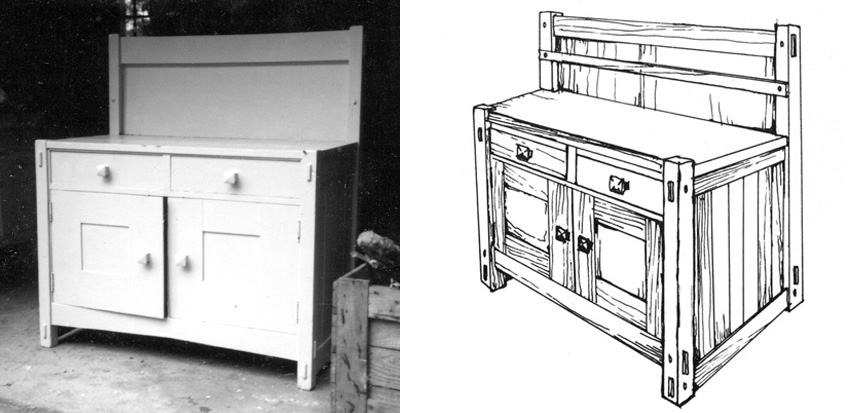
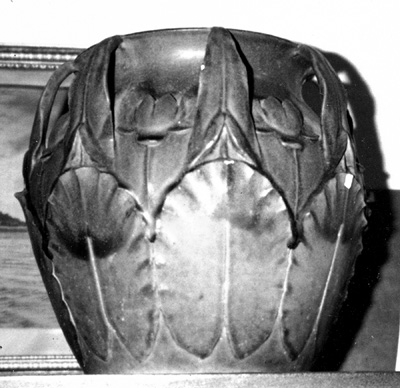
This large and rare Teco jardinière has various chips and flakes along the raised leaves. To my mind, restoration does not affect the value to a museum that wants to exhibit its aesthetic qualities, but I am in the minority among those who are qualified to vet such objects.
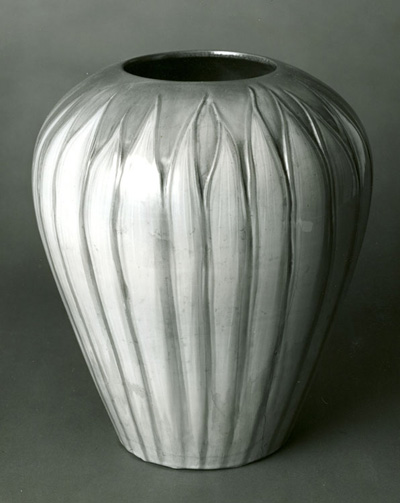
Lacking any documentation, I always assumed this grand Frederick Rhead vase was acquired by Ralph and Jane Whitehead while they were living at Arcady in California and brought to White Pines at Byrdcliffe when they moved to New York permanently. At some point before 1980, the bottom of the vase was smashed out of it and it was crudely restored. Before selling it to (then private) collectors in 1999, the vase was professionally restored, which meant that much of the distinctive flowing glaze had to be overpainted. The vase not only has a new luster, but, after it was sold, it acquired an exciting new history: Now Rhead himself supposedly brought it to Byrdcliffe where he glazed it in the White Pines kilns. Will any curator bother to vet this story by scrutinizing the Byrdcliffe papers? Does the story enhance the value of the vase?

When this Rohlfs “Banquet” came into my inventory it looked as if someone had tried to remove a later coat of bronze powder without disturbing the underlying dark finish. It was fitted with two glass shelves. In The Artistic Furniture of Charles Rohlfs the finish is listed as ebonized and gold-rubbed oak and the glass shelves have been replaced with parts that duplicate the look of the candelabrum as it appeared in a 1907 Rohlfs catalogue, which describes the copper as being polished. A huge photographic detail on page 240 of the book highlights only the new parts.
Most of the objects I lent to Boston eventually ended up in museum collections anyway, but the public is seldom aware of the real reasons objects are displayed in museums or how those objects got there—it is not always or even often for reasons of aesthetic or historical merit. For better or worse, art museums large and small would look very different if they gave more than lip service to AAM, AAMD, and ADA1900 edicts. The Metropolitan Museum of Art (among others) still displays objects given by the Jordan-Volpe Gallery, which, according to Tod Volpe, were given explicitly to improve the nascent Arts and Crafts market:
Nonnie Frelinghuysen, curator of decorative arts in the American Wing of the Met, was one of the [Jordan-Volpe] gallery’s primary supporters. As a connoisseur of turn-of-the-century decorative arts, she and fellow curator Craig Miller were aware of the gap in collecting that we were attempting to fill … By putting an important art object on display in a major museum, I was able to draw old clients back to the gallery and take new ones to new heights … We continued to donate art to the Met during the 1980s. Great examples of furniture bear our name as do objects and metalwork. For what seemed like a sizeable sacrifice to others, to me, what we were doing made total sense. We were able to sell millions of dollars in art as a result of those simple donations. (Volpe, Tod. Framed: America’s Art Dealer to the Stars Tells All. Ontario, Canada: ECW Press, 2003)
Miller is long gone from the Met, but Frelinghuysen continues to hold sway and dealer donations continue to define the collection. Where would their Herter collection be without Margo Johnson? Is Robert Ellison, who recently gave a multimillion-dollar collection of American art pottery to the museum, more or less of a dealer than Stephen Gray?
.
.
.
When Jordan-Volpe gave this Stickley cabinet to the Met, Harvey Ellis was thought to have designed it even though the case and the inlay do not reflect his style. Examples of this early cabinet were and are rare, but the icebox-like shape and the inlay, which copies a European design, were never popular with collectors who value aesthetics over rarity.
The self-appointed curator of ADA1900 (no connection to Americandecorativeart.com, which is not a philanthropic foundation) thinks it does. Not content to sit on the heap of laurels he is raking in for his highly vaunted work on Charles Rohlfs, he and his significant other send out righteous e-mail alerts to Dear Friends and Colleagues attacking any competitor in their rather broadly defined field. In 2006 they lambasted The Two Red Roses Foundation whose founder had the temerity to outbid them at auction for objects they wanted for their own private foundation. Their missal chastising the Wadsworth Atheneum’s Gray exhibit distorts the newspaper article with calculated spin worthy of Rove or Cheney:
Most distressing is the checklist, which serves to validate the authenticity of objects, even though the museum is without a curator of American decorative art and did not engage any independent curator to vet them.
I don’t see the checklist as anything but a redundant appendix to the catalogue. Since there can be little doubt about the authenticity of Gray’s objects, I must assume that the issue is really restoration, and I know of no museum curator who knows enough or cares enough about Gray’s collection to vet it with the kind of laboratory analysis it would take to describe what is original and what has been repaired. Many Arts and Crafts objects now in museum and foundation collections would not stand up to such scrutiny.
The doctors wrote:
As reported by Jason Kaufman, the exhibition At Home with Gustav Stickley: Arts & Crafts from the Stephen Gray Collection at the Wadsworth Atheneum presents “a private collection destined for the market.”
But the actual newspaper quote does not accuse the Wadsworth directly:
Museums rarely show dealer collections because “it would look like you were hawking someone’s wares,” observes Ford Bell, president of the American Association of Museums (AAM), which along with the Association of Art Museum Directors (AAMD), sets guidelines for art museums in North America. But the same issues arise when showing private collections destined for the market.
AAM, AAMD, and ADA1900 are all being disingenuous. Dealers who can afford to often save the best fine or decorative art objects for themselves. “Museums rarely show dealer collections” unless they hope to get those collections as gifts, but few shows would have guts without some sort of winking arrangements between museum curators and dealers. Decades ago I lent so many objects to Boston’s The Art That Is Life that the curator felt the need to hide my loans by using several different lender names in the catalogue. Some of the objects were from my personal collection and some were from my inventory—I made it clear on the loan forms that, though I would not remove the objects from the show, they were my livelihood and I might need to sell them before the show’s two-year run ended. I didn’t lend the objects to increase their resale value; I lent them at the museum’s request. To my mind my objects increased the value of the exhibit, not the other way around. As it happened, I needed money more than I needed a collection, so I used slides to auction some of the objects the museum borrowed. I suppose the museum’s subsequent show of outrage was necessary so it wouldn’t seem to be complicit in “hawking someone’s wares.”


An important part of Jordan-Volpe’s marketing technique was the way they processed their inventory. The simplicity (not to say dullness) of most Arts and Crafts objects has little appeal to the kind of trend-following clients the gallery intended to gull. Once in a great while a piece of Arts and Crafts furniture survives in perfect untouched original finish, which for some of us makes it not only more beautiful than other identical examples but more desirable. This kind of rarity required a collector to have a modicum of erudition and could not sustain an artificially inflating market. Jordan-Volpe wisely chose to spread the same jewel-like, dazzling varnish over everything—the good, the bad, and the ugly—so all would shine with the color of money under the golden glow of gallery spotlights.
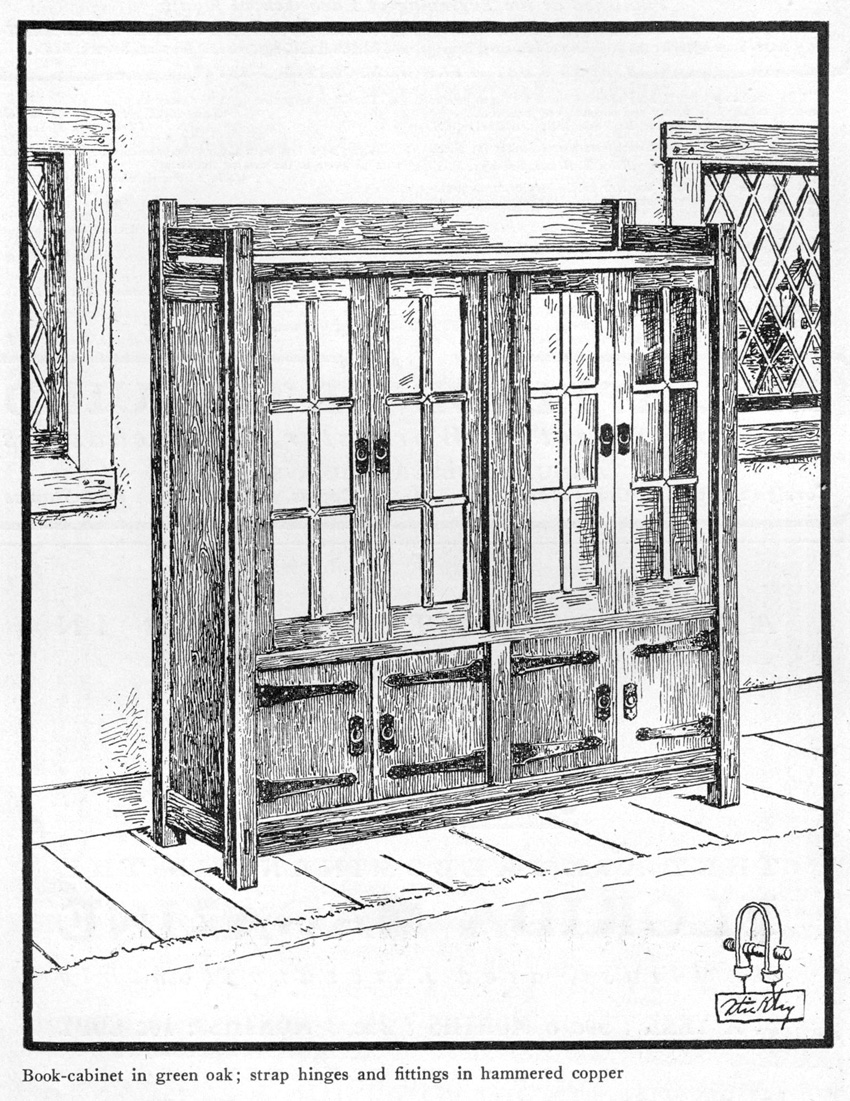
A rather violent green stain, unsuited to modern taste, was favored by many manufacturers of turn-of-the-century furniture—among them were producers of Arts and Crafts-style furniture like David Kendall, Joseph McHugh, the Stickley brothers, and Charles Rohlfs, who doubtless started the nationwide fad to honor his wife Anna Katherine Green. Gustav Stickley’s version was particularly ephemeral and changed to an appealing rich red/brown color that almost looks intentional until one examines the parts of the oak that were not exposed to air where remnants of viridian remain. Back in the day, most dealers made sure all evidence of the then undesirable color was removed.
Back then, no one knew how much of what kind of Stickley was still languishing in barns and attics, so the gallery took a calculated risk: They based their price structure on a hierarchy of rarity that did not depend on the fine points of connoisseurship, which had long guided collectors of earlier American decorative arts. They perceived that Gustav Stickley’s early, lumbering designs would not appeal to big spenders, even though those pieces best represent the ideals of the Arts and Crafts movement. They were not in business to sell the existing history of the movement so they wrote their own history, which valued medium over message. The more effete designs of Harvey Ellis sometimes have inlaid metal designs, which are tepid interpretations of progressive (“Progressive”? Now there’s a key spin word!) British or European designs. Delicate Ellis designs along with the “spindle” line would appeal to buyers with white-walled penthouses on the top of the Carlyle. Volpe and Beth Cathers made the Ellis stuff seem especially rare by publishing a quote from Gustav Stickley’s aging daughter, who mistakenly remembered that inlaid furniture was custom made only for display in Stickley’s retail outlet windows.
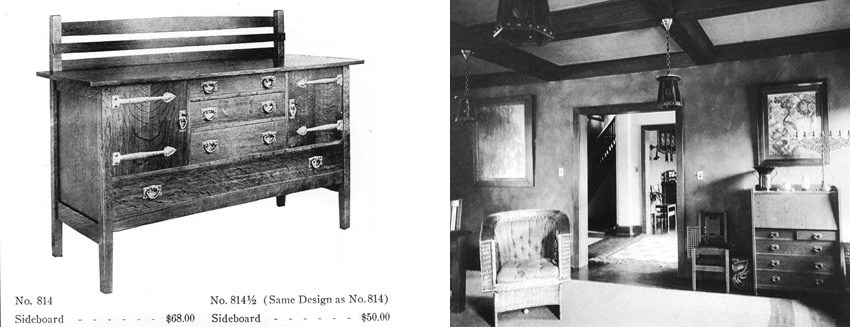
The Gustav Stickley factory produced variations of sideboard #814 over a long period of time—the unassuming design was offered in several different sizes, making it adaptable to many interiors regardless of style. Its popularity, then, means that there are many examples extant now. A material culture museum might well acquire #814 as an example of the convergence of popular taste and Stickley’s democratic ideals.
Architect Will Price seldom specified furnishings for his domestic designs, so the owner might have chosen #814 (visible through the doorways) for his 1911 New Jersey house.
Private collectors and museum curators were, like so many lazy fish, eager to take the flashy bait. I offered a massive early Gustav Stickley sideboard in pristine original condition to a Houston museum whose curator responded that she wanted only the most rare and best examples. She said she would send a Volpe photograph of the kind of sideboard she dreamed of acquiring. I was amazed to discover she coveted a late, ordinary sideboard (814) so easy to find that I often turned down examples as being too pedestrian for my clients. I failed to realize how its availability could build the market; it could be donated to multiple museums where potential clients could see it and then acquire one from the New York gallery at a price enhanced by a museum imprimatur. I sent a Charles Rohlfs rocking chair in original finish out to Max Palevsky on approval. He returned it, allowing as how he preferred the Jordan-Volpe shine. Palevsky’s donations now form the core of the Arts and Crafts collection at the Los Angeles County Museum of Art. They display an identical rocker with a new finish and new leather—I don’t know if it is actually my example gussied up, but stranger things have happened. Another collector rejected a monumental Grueby vase when it was offered to him in “as-found” condition. He didn’t trust the “dry” surface. The vase found its way to the Jordan-Volpe Gallery, which sold it to the same collector for more money after the glaze got oiled up with their trademark treatment. That vase is now in the ADA1900 collection.
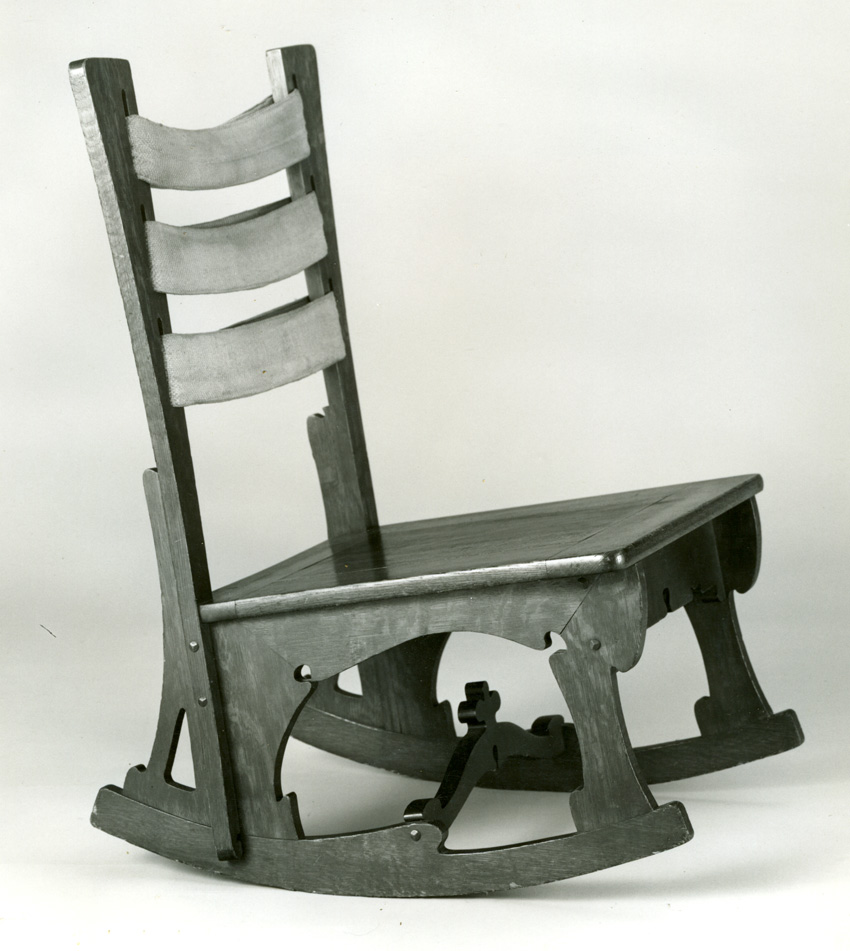
With the show, the Wadsworth Atheneum published a book on Mr. Gray’s home and collection. It falls far short of their usual standards for scholarship and makes no contribution other that to inflate the value of Mr. Gray’s objects. Apart from a brief survey by David Cathers on early Stickley furniture, the book looks like a combination of shelter magazine and auction catalogue.
The University Press of New England (UPNE) distributes Gray’s book with the Atheneum’s byline—UPNE is essentially a vanity press, which requires all the expenses of writing and photography to be borne by the author. The press has no expertise in the wide-ranging subjects they accept—all it does is copyedit and distribute books, so it’s easy to see how all the folksy photos of Gray with his Airedale and Mac got into what is ostensibly a museum catalogue. Except for coining the comically literal term “Early Work” to describe Gray’s prescient primary interest in Stickley, the museum never represented the exhibit as anything more scholarly than a bunch of cool, crowd-pleasing stuff from one man’s collection. The galleries were packed when I was there, so apparently the hoi polloi enjoyed themselves as much as elite Stickley collectors did not—how Arts and Crafts is that? A museum’s standards get adjusted accordingly at a time when head count is paramount. Can there be any doubt that fashion designers have managed to sell a whole lot of product by making less-than-scholarly arrangements with art museums like the Met or the Guggenheim? You do what you have to do.
The Wadsworth may have been lured by the package, which included a catalogue, readily available objects, gifts, and, most importantly, partial funding, but that’s no different from the 2003 Rookwood Pottery show at the Philadelphia Museum of Art or the upcoming Rohlfs show at Milwaukee. Many museums jump through hoops to accommodate private collectors, who string them along with promised gifts, only to have their hopes dashed when the collectors change their minds. Museums unavoidably inflate the value of an object, which might help the collector who intends to sell retail or at auction, but it undeniably helps the taxes of the private collector who makes gifts:
In connection with the forthcoming exhibition The Artistic Furniture of Charles Rohlfs, which is organized by the Milwaukee Art Museum, the Chipstone Foundation, and ADA1900 Foundation, we have made a formal commitment that all of the objects from our personal collection would eventually go to museums.
Eventually can be a long, long time. A will, after all, is a formal commitment, and many of the Rohlfs objects in Cunningham’s book are promised gift[s] of American Decorative Art 1900 in honor of Joseph Cunningham. The self-aggrandizing honor again raises the specter of Cheney appointing himself vice president while the promise leaves the donor with a troubling amount of sway. One wonders how museum professionals feel about the honor and the promise. A curator at one large art museum, which notably seems not to have received an ADA1900 swag bag, told me they would, of course, do what they had to do to work with “Bruce and Joe” because they wanted the gifts. Sway and swagger play important roles in the foundation’s work and will, for better and worse, have a lasting effect on the study of American Arts and Crafts.
I will consider The Artistic Furniture of Charles Rohlfs in more detail after I’ve seen the companion exhibit, but there are a few points relevant to this discussion of Stephen Gray’s collection. Dr. Cunningham’s substantial opus will not seem like a combination of shelter magazine and auction catalogue to a reader unfamiliar with the behind-the-scenes workings of ADA1900 and the Arts and Crafts market, but it falls far short of [The Chipstone Foundation’s] usual standards for scholarship while doing much to inflate the value of [ADA1900] objects. Still, as the doctor predicts, it will undoubtedly be the last and, perforce, definitive work about Rohlfs for a very long time.

Dr. Cunningham writes, The bench’s [left] overall design and construction likely influenced the designer’s contemporary Gustav Stickley in nearby Syracuse. Buffalo is nearer to Syracuse than Olde England or New England, but Stickley’s settle design descends directly from contemporary British designs and Early American models. The solid, high back (missing in the Rohlfs bench) was essential functionally as such settles were set beside fireplaces to form inglenooks where warm air could be concentrated. Dr. Cunningham asserts that the Stickley settle is not finished on the back the way the Rohlfs bench is, which, to him, means that it had to be placed so the back was not visible, yet Stickley himself noted the potential for his settles to be used as room dividers. Since other versions of Stickley’s settle do not have the same lithe shaped ends, one would have to know which Stickley settle was designed first to establish even a slightly plausible comparison to the Rohlfs bench. But I quibble—they are both made of oak and they both have remarkably similar horizontal boards likely meant to be sat upon.
Sarah Fayen’s introduction attempts to separate Rohlfs from the American Arts and Crafts movement by redefining the movement. She, with many other scholars, conflates philosophical ideas about simplicity with the movement style, which she sees as primarily simple or “Mission” exemplified by Gustav Stickley. More thoughtful scholars recognize the very strong alternative convention that includes the far-from-simple work of John Scott Bradstreet, Will Price, Karl von Rydingsvärd, Alice Pike Barney, Arthur and Lucia Mathews, Charles and Henry Greene, Louis Sullivan, Frank Lloyd Wright, Reginald Machell, and Frank Jeck, to mention but a few who designed in wood, among hundreds of other artisans whose work in metal, ceramics, glass, and textiles goes way beyond simple.

The list of objects used to support the authors’ subjective thesis, which is that Rohlfs was radically different from and superior to his contemporaries and that he was globally influential, is limited and biased toward the ADA1900 collection. A broader, more objective view would present more useful, accurate information even if it wouldn’t inflate the value of his furnishings as much. The Rohlfs table on the left had a green stain originally. It has many more similarities to the likely later L. & J. G. Stickley table on the right than the Rohlfs bench and Gustav Stickley settle discussed above have between them, but it cannot be said that one influenced the other. The point here is to show how Rohlfs can be fit into the Mission mainstream.
One might argue that studies of the Arts and Crafts movement or Art Nouveau have been too inclusive, as Dr. Bruce Barnes does. He writes, Rohlfs considered himself a maker of ‘Artistic Furniture’ with a highly individualistic style and Surprisingly, his earliest surviving works, made around 1888, long before the Arts and Crafts Movement became a force in the United States, exhibit many characteristics of his mature style. I don’t have a doctorate in American decorative arts, but some who do agree with me that the Arts and Crafts movement became a force in the United States starting in 1876 at the Philadelphia Centennial Exposition, where highly individualistic, artistic furniture was much in evidence. It may take a leap to get from Charles Rohlfs to Gustav Stickley and then to the American studio furniture movement, but it takes baby steps to get from Belter and Meeks to artistic furniture made under the tutelage of Henry and William Fry to that made by Rohlfs and his wife.

John Henry Belter, New York, circa 1855
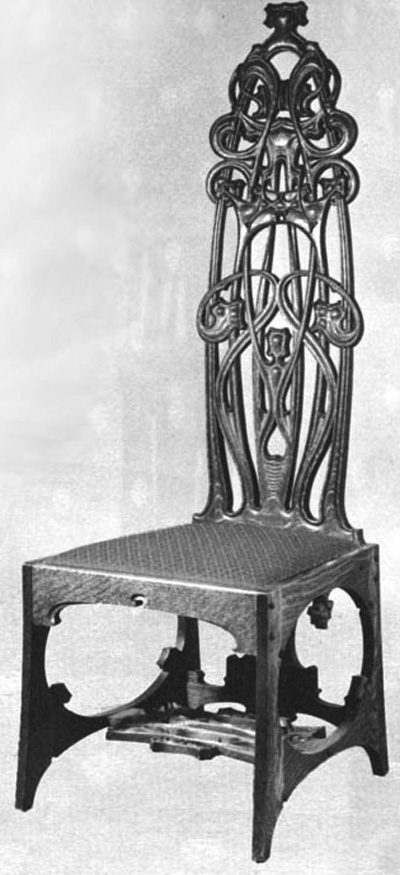
Charles Rohlfs, NewYork, circa 1898
.
The book makes much of the contribution of Anna Katherine Green Rohlfs, whose possible foray into furniture design and making is characterized as unprecedented. Sarah Fayen writes that among home crafts, “woodworking would have been a man’s hobby.” This, of course, ignores the fact that many Cincinnati women made mountains of elaborately carved furniture after studying with the Frys and Benn Pittman, and most of Karl von Rydingsvärd’s students were women. Another home craft often done by women has a strong connection to Rohlfs furniture: Late in the nineteenth century, pyrography, or wood burning, was wildly popular among both males and females. All manner of household woodenware was embellished in low relief with a sharp, hot tool, but it is the furniture that relates to Rohlfs. Broad planar surfaces were needed to show pyrographic designs to their best advantage, so chairs and tables were made up of wide boards, which were often cut into fantastic shapes reminiscent of some of the flat shapes Rohlfs used.
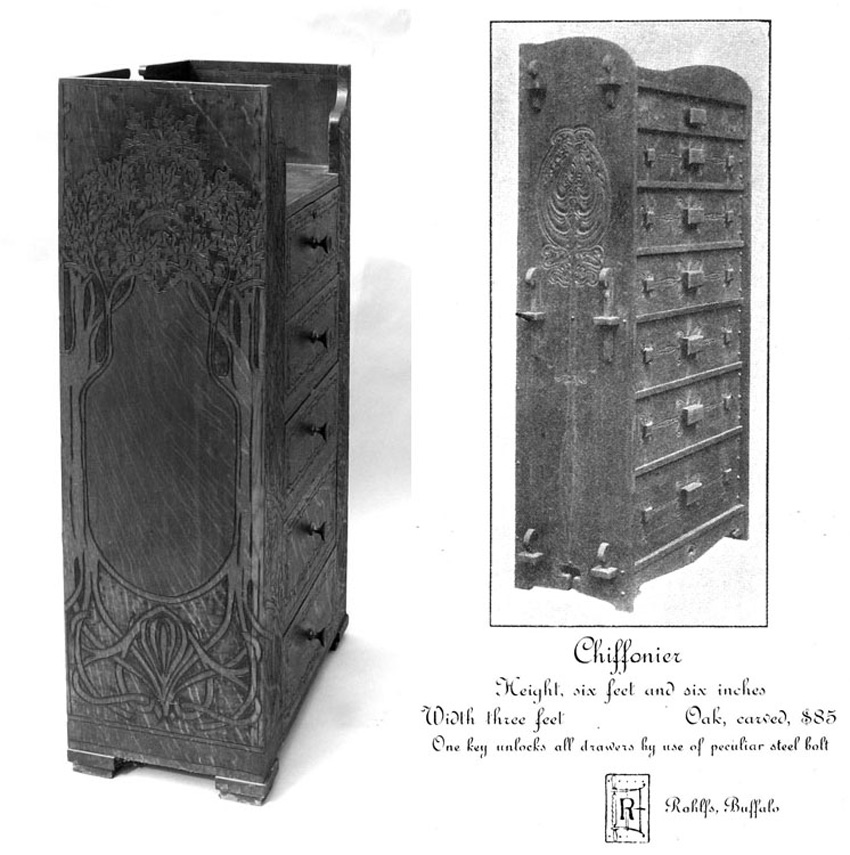
While it is difficult to date such examples of pyrography as the chest of drawers and the tabourette on the left, the hobby of burning designs into wood was very popular from the 1890s through the 1920s. The Art Nouveau style remained in use by wood-burning enthusiasts long after it had generally fallen from favor. It is not likely that Rohlfs influenced the decorators of these pieces, but both Charles and Anna Katherine would have been familiar with the technique well before they started making furniture.
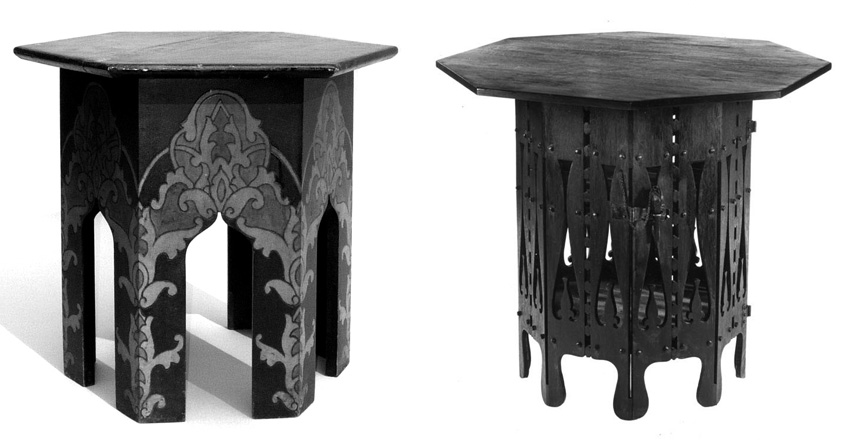
.
The book attempts to make Rohlfs more remarkable than he is already known to be by taking him out of the context in which other scholars have put him:
Some have argued that Charles Rohlfs is a representative of the Art Nouveau Movement in America. For example, his iconic carved tall back chair was appropriated (along with several works from the Prairie School Movement) in the Victoria and Albert Museum’s overinclusive recent [2000] Art Nouveau exhibition.
More recently (2005), the Victoria and Albert Museum included Rohlfs and the Prairie School in their International Arts and Crafts exhibit. I, too, wonder about the need to pigeonhole eccentric artisans like Bugatti and Mackintosh or indeed Rohlfs, but there is something to be learned when careful thinkers do the sorting.
.
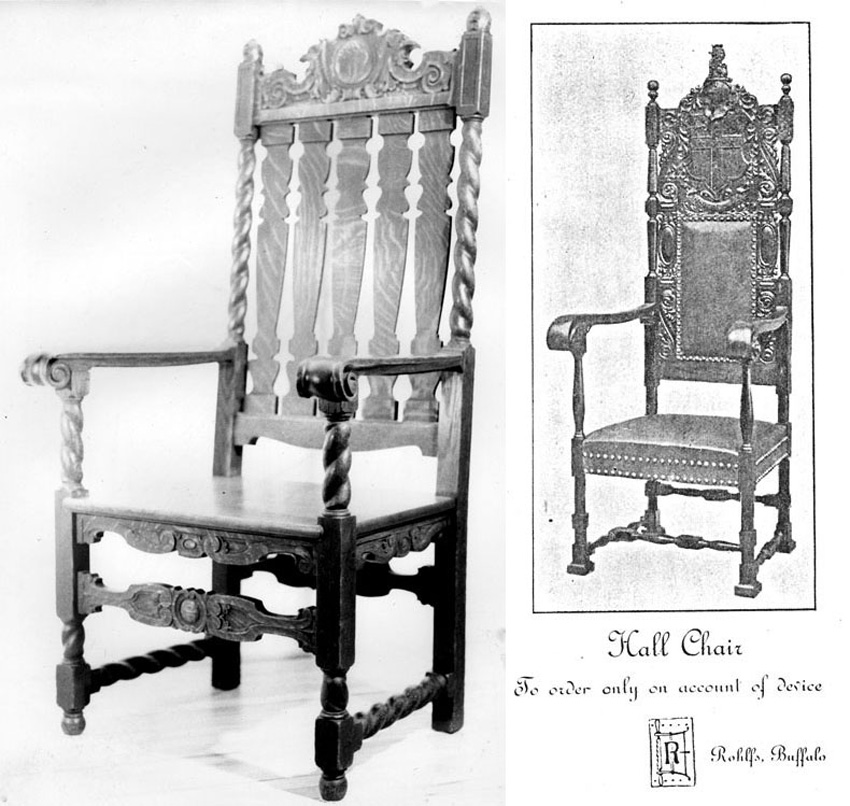
No actual copies of historic styles are included in the Rohlfs catalogue perhaps because his reproductions are so badly designed, but he did make such furniture. Will Price interpreted the Jacobean style (left) with far more success for his Rose Valley furniture factory. It could be that the first chair Rohlfs carved exists but is not now recognized because it does not relate to his developed style.
.
.
There is less to be learned from those who seek to promote their own dictums by denouncing all others with needlessly pejorative words like appropriated and non-words like overinclusive. The doctors criticized the Wadsworth exhibit:
Tommy McPherson takes pains to praise Mr. Gray’s objects, while needlessly derogating the furnishings of Gustav Stickley’s homestead at Craftsman Farms.
McPherson merely compares a public building that Saint Gustav himself jerry-rigged to use as a private home furnished with bits and pieces left over from a long career in furniture manufacturing to a farmhouse that Gray jerry-rigged to accommodate a very carefully assembled collection of Stickley furniture. I read no subjective qualitative judgments or painful praise. On the other hand, because the examples used in the Barnes and Cunningham book are almost all from their private foundation, it is true to say they take pains to praise their own stuff while needlessly derogating all previous studies of Rohlfs. As everyone knows, the longer the list of references in publications and exhibitions a piece has, the higher the value it has on the market and on the IRS gift form.
The perfume of the book’s orgasmic verbiage covers up a lot of miasmic speculation:
The front face of the desk falls open to reveal an interior cabinet with a lower shelf and an upper shelf from which two exquisitely proportioned drawers hang. Its exterior is adorned with one of Rohlfs’s first attempts at the carved rendering of smoke rings, the likes of which were perhaps puffing up from his pipe as he rendered the stylized medallion of interlocking lines, rings, and ribbons, pinned at its center with an oak rod. Adorning the full ascent of the upper section are carved and fretted flames, made of seemingly interlocking strands of oak that are all actually carved from a single piece of wood. The flames are rooted with rectilinear bulblike junctures that also conceal joinery. These flames were likely designed by Charles or Anna Katherine or perhaps as a collaboration between the designer and the author: the graphic image on the cover of her novel Doctor Izard (1895) bears an unmistakable resemblance to the design. At the arched dome [When is a dome two-dimensional? When it’s on a Rohlfs side panel.] of the two side panels, the flames complete the top of the desk with a dramatic gesture while showcasing at eye level Rolhfs’s mastery as a woodcarver.
Unqualified, mental meandering is conflated with analysis and left to accrue as credible scholarship when there is actually very little new fact-based research:
[The Green Man] motif, prevalent throughout Europe, would have been especially apparent in Charles’s and Katherine’s travels through England, where such “Green Man” imagery is ubiquitous and would have been included in the decorative schemes of many of the churches and other public buildings the couple visited. Polly Rubin suggests that Anna is “Green” and Charles is “Man.”
Panama Red or Acapulco Gold?
The book is padded with unedifying quotes from the Rohlfs journals:
On 10 July, in Anna Katherine’s words, “Mrs. and Miss Coues [who’s significance is nowhere shared with the reader] … bid us goodbye,” and the family traveled to Canterbury, where they “walked through the park and rambling narrow streets” and “visited the cathedral.”

No more or less bizarre than many Rohlfs designs, “green man” quartered-oak chairs like this were mass-produced in great numbers beginning in the 1890s for a middle class with a taste for “artistic” furniture.
Reginald Machell was born in England and studied art there and in France. He became a Theosophist in 1887. He made interior decorations for the Theosophical Society’s London headquarters in 1890 before coming to Point Loma, California in 1900. The unique carved designs on his furniture derive from Theosophical doctrine.

The highly selective list of objects discussed in the book and the determination to see Rohlfs as a visionary rather than an eccentric distorts his place in the history of decorative arts:
A spare and elegant set of similarly restrained cross-stretchers [not inconsequentially, box stretchers in this instance] form [sic] a boxlike apron supporting the structure of the Crib and giving a skirted sensibility to its midsection. This boxed cross-stretcher is a formation that A. Page Brown and Bernard Maybeck were to use, the very next year, near the foot of their celebrated “Mission Chair” designed for the Swedenborgian Church, San Francisco, 1893. The severe minimalism of the Crib is mitigated only by the inspired use of decorative screw heads, gracefully placed in vertical pairs immediately near the corner joints of each post. This merging of joinery calls to [Cunningham’s] mind the shaped wooden plugs Rohlfs used extensively on later furniture and anticipates the decorative ebony pegs featured fifteen years later in the furniture of Charles Sumner Greene and Henry Mather Green [sic].
The more delectable aspects of these quotes and others will have to be examined in Part Deux because I want to bring the discussion back to Gray versus ADA1900. Gray’s book is far less pretentious than the Doctors Barnes’s and Cunningham’s—it’s a gray old man’s fond summation of his lifelong passion. I can relate to that although, in my dotage, I regret having wasted any passion on furniture. As handsome as the book is and the exhibition was, they didn’t get their good looks by spending tons of money. The Atheneum even solicited financial support from the Stickley old garde, including dealers from whom Gray bought parts of his collection. If Gray’s production makes no contribution to scholarship, it may be that it does not pretend to, which is probably wise since ideology ought to occupy a limited area in art museums devoted to aesthetics.
While the look of the Rohlfs exhibition remains to be seen, the lavish look of the book could not have happened without a huge and controlling investment from the authors, who technically still own most of the Rohlfs objects under consideration. Pay-to-play goes a long way to explain how all that palaver got past rigorous eyes at the Chipstone Foundation. Even so, somebody outside ADA1900 should have had the balls to put a lid on Pandora Cunningham’s box before its vapors escaped to smudge the world’s decorative arts.
One might allow Rohlfs some credit for Gustav Stickley’s little flower tables, but the suggestion that Rohlfs was the likely inspiration for a Stickley high-backed settle, a Frank Lloyd Wright table, a Hector Guimard mirror, a Charles Rennie Mackintosh desk, a Gerrit Rietvelt chair, a George Grant Elmslie chair, a Joseph McHugh desk, or a Greene and Greene peg is untenable.
The Rohlfs show is traveling to much fancier and more powerful museums than the Wadsworth. If someone persuades his little newspaper to review the ADA1900 extravaganza, one can hope Mr. Kaufmann will be fair and objective enough to apply the same standards he used for the Gray production.

“Artistic chairs” from Select Furniture in All Styles, Timms and Webb, The Furniture Press, London, 1890.

Tripod tables from a copy of Select Furniture in All Styles, Timms and Webb, The Furniture Press, London, 1890 that was owned by a New York furniture designer whose pencil drawings in the margins show simplifed “mission” designs based on these elaborate Edwardian confections. That particular designer did not live and work near Buffalo or Syracuse.